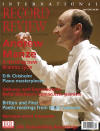Texte paru dans: / Appeared in:
*

International Record Review - (04/2012)
Pour
s'abonner / Subscription information
Metronome
METCD1086
5028165108626
Consultez toutes les évaluations recensées pour ce cd
~~~~ Reach all the evaluations located for this CD
In seventeenth-century England the much loved traditions of the Renaissance were slow to make way for new Baroque ideas from Italy. It wasn’t until after the Restoration of Charles II in 1660 that the British Baroque style really began to flower and when it did it was delightfully quirky. The man at the forefront of re-establishing music at the Restoration was Matthew Locke: a Catholic, a bit tricky personally, but an open-minded and pragmatic composer. Charles employed him to compose for the court violin band (the 24 Violins) and for his private entertainment.
One of the first things Locke wrote for his new king in 1661 was a set six suites for two violins, viola da gamba and continuo which was intended for a group known as the Broken Consort which had played contrapuntal fantasias for Charles I. Yet rather than write his fantasias like those of earlier generations of composers (Orlando Gibbons and William Lawes) Locke updated the form, giving it a slow introduction, making it less contrapuntal and more whimsical, and using rapid modulations and spicy harmonies to grab the attention. We can hear Locke at his best in the Fantasia to the Sixth Suite (Broken Consort, Part 1), where in the middle of the piece everything suddenly stops for a soft passage of wild modulations intended, surely, to startle the royal ears and make sure they were paying attention — and it works just as well in this dramatic performance.
This is the first complete recording of both the first and second parts of Locke’s complete Broken Consort music, but the appropriately named Locke Consort has been playing this music for over 20 years and it knows every nook and cranny of Locke’s angular and unpredictable style. In fact, its greatest strength is to bring a convincing shape to Locke’s often quite wayward melodic phrases and harmonic movement, as in the Jigg from the Fifth Suite (Part 2), to which it adds a wonderful square-toed, rustic quality but then gives generously of its tone as the music unexpectedly slows and broadens out during the second half.
Various anecdotes survive about Charles Ils relatively unsophisticated musical tastes: he apparently hated the old-fashioned contrapuntal fantasia and seems to have preferred something he could tap his foot to. So it’s no surprise that none of the five suites of The Broken Consort, Part 2 contains a fantasia, but all of them have plenty of jaunty stuff - jigs and the like. These Broken Consort, Part 2 remained unfinished: there are five rather than six suites and only the first two survive in authorized copies in Locke’s hand. Perhaps the King had lost interest in this rather formal English style of music. He certainly seems to have preferred the lighter French manner which he sampled during his years of exile at the court of the young Louis XIV. Locke, too, enjoyed writing in this style, and The Locke Consort has included a pair of those tuneful, French inspired and musically Catholic suites which Locke published in the collection Tripla concordia which he edited for John Carr in 1677. Described by the publisher as being ‘Music A-la-mode’ — i.e. in the style of Jean Baptiste Lully --- it is infused with plenty of courtly Gallic charm in The Locke Consort’s performance, though it is not afraid to play up a great English Country Dance or Hornpipe when it gets one.
The Locke Consort exudes real flair and swagger in this music, with an individual waxy, gutty, violin tone midway between the sound of viols and the more graceful style of later Baroque violin playing we are generally used to. In places the wildness of its tuning exactly matches the spikiness of Locke’s music — elsewhere, occasionally, it’s just a whisker out of tone. Compared with Peter Holman’s pioneering recording of thee first part of The Broken Consort made back in 1994, The Parley of Instruments is perhaps better toned but rather less interesting, tending to smooth out some of Locke’s delicious idiosyncrasies rather than mountaineering over them like The Locke Consort. Though Holman’s use of Oxford sources means that he uses three theorbos rather than The Locke Consort’s one, this latest CD is so well balanced that Fred Jacobs (common to both recordings) is perfectly placed, at the centre of the ensemble, to animate the dance movements and regulate the pleasingly elastic tempos.
Overall this is a wonderful way to discover the idiosyncratic early English Baroque. The Locke Consort doesn’t air-brush Locke for us; we got him in all his vivid, spiky individuality
- just like the prickly gooseberries by
Adriaen de Coorte (c1683-1707) which grace the front cover. If we learn just
one thing from this recording it’s that without Locke there would have been
no Purcell, not as we know him, anyway.
Fermer la fenêtre/Close window
Cliquez l'un ou l'autre
bouton pour découvrir bien d'autres critiques de CD
Click either button for many other reviews


